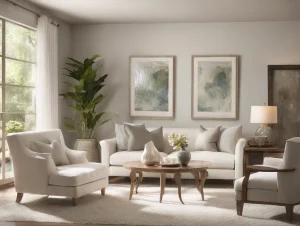In the hustle and bustle of modern life, where rapid technological advancements often overshadow the simplicity of the past, there remains a profound appreciation for the enduring charm and timeless elegance of Craftsman-style homes. As someone who has always found solace in the art of home organization and decoration, I have come to realize that the intrinsic beauty of Craftsman homes speaks not just to the eye, but to the soul. In this reflective piece, I invite you to explore the allure of Craftsman style and discover how its principles can be seamlessly woven into the fabric of contemporary living.
The Roots of Craftsman Style
The Craftsman style, which emerged in the early 20th century, was a direct response to the industrial revolution’s mass production and the ornate excesses of the Victorian era. It championed the values of simplicity, functionality, and handcrafted artistry. Pioneered by the likes of Gustav Stickley and the Greene brothers, this architectural movement placed a premium on natural materials, sturdy construction, and a harmonious relationship between the home and its surrounding environment.
As I walk through the halls of my own Craftsman-inspired home, I am reminded of the movement’s foundational principles. The exposed beams, the built-in cabinetry, and the meticulous woodwork all serve as tangible reminders of an era that valued quality and craftsmanship over mass production. These elements not only add to the aesthetic appeal of the home but also evoke a sense of warmth and authenticity that modern designs often lack.
The Timeless Appeal of Natural Materials
One of the hallmarks of Craftsman style is its use of natural materials. Wood, stone, brick, and glass are central to its aesthetic, creating a connection to the natural world that is both grounding and comforting. In my own home, I have made it a point to incorporate these materials wherever possible. The rich oak floors, the stone fireplace, and the handcrafted wooden furniture all contribute to a sense of continuity and coherence that is deeply satisfying.
In today’s world, where synthetic materials and disposable furniture are all too common, the use of natural materials in a Craftsman home serves as a reminder of the importance of sustainability and environmental stewardship. By choosing materials that are both beautiful and durable, we can create living spaces that not only stand the test of time but also honor the planet we call home.
Functional Beauty: The Heart of Craftsman Design
At its core, Craftsman style is about more than just aesthetics; it is about creating spaces that are both beautiful and functional. This emphasis on practicality is evident in the thoughtful design elements that define Craftsman homes. Built-in bookcases, window seats, and nooks are not just decorative features; they are designed to enhance the functionality of the home and make everyday living more enjoyable.
In my own journey of home organization and decoration, I have found that these functional elements are invaluable. The built-in bookcases in my living room not only provide ample storage for my ever-growing collection of books but also serve as a focal point that draws the eye and adds character to the space. The window seat in the dining room, with its cozy cushions and soft lighting, has become a favorite spot for morning coffee and quiet reflection.
By prioritizing functionality without sacrificing beauty, Craftsman design offers a blueprint for creating homes that are both practical and pleasing to the senses. It is a reminder that true beauty lies not in excess, but in the thoughtful details that make a house a home.
The Power of Handcrafted Artistry
In an age where mass-produced goods dominate the market, the handcrafted artistry that defines Craftsman style is a breath of fresh air. The meticulous attention to detail, the skillful craftsmanship, and the unique, one-of-a-kind pieces all contribute to a sense of individuality and character that is unmatched by factory-made products.
In my own home, I have made it a point to incorporate handcrafted elements wherever possible. The hand-carved wooden mantel in the living room, the custom-made stained glass window in the hallway, and the artisanal pottery in the kitchen all serve as reminders of the beauty and value of handcrafted artistry. These pieces not only add to the aesthetic appeal of the home but also tell a story of the skilled artisans who created them.
By celebrating and supporting craftsmanship, we can create homes that are not only beautiful but also imbued with a sense of history and meaning. It is a way of honoring the past while creating a legacy for the future.
Embracing Modern Innovations
While Craftsman style is rooted in tradition, it is by no means incompatible with modern innovations. In fact, one of the reasons for its enduring popularity is its ability to adapt to contemporary needs and lifestyles. By blending the timeless principles of Craftsman design with modern technology and conveniences, we can create homes that are both classic and cutting-edge.
In my own home, I have embraced this fusion of old and new. The sleek, energy-efficient appliances in the kitchen, the smart lighting system in the living room, and the state-of-the-art home office all coexist harmoniously with the traditional Craftsman elements. This blend of modern innovation and timeless design creates a living space that is both functional and aesthetically pleasing.
By incorporating modern innovations into a Craftsman-style home, we can enjoy the best of both worlds: the timeless beauty and craftsmanship of the past, and the convenience and efficiency of the present.
Creating a Sense of Community
One of the most cherished aspects of Craftsman-style homes is their emphasis on creating a sense of community and connectedness. The design of these homes often includes features that encourage social interaction and foster a sense of belonging. Large front porches, open floor plans, and shared living spaces are all designed to bring people together and create a sense of warmth and hospitality.
In my own neighborhood, which is filled with Craftsman-style homes, this sense of community is palpable. Neighbors gather on front porches for evening chats, children play in shared green spaces, and community events are held in the local park. This sense of connectedness is a testament to the timeless appeal of Craftsman design, which values human connection and social interaction.
By creating homes that foster a sense of community, we can build stronger, more resilient neighborhoods and create a sense of belonging that is essential for our well-being.
A Personal Reflection
As I sit in my living room, surrounded by the warmth and beauty of my Craftsman-inspired home, I am filled with a deep sense of gratitude. The rich woodwork, the functional design elements, and the handcrafted artistry all serve as reminders of the values that are important to me: simplicity, sustainability, and a connection to the natural world.
In a world that often seems focused on the latest trends and fleeting fashions, the timeless appeal of Craftsman style offers a reassuring constant. It is a reminder that true beauty lies not in excess, but in the thoughtful details and enduring principles that make a house a home.
As I reflect on my own journey of home organization and decoration, I am reminded of the words of Gustav Stickley, one of the pioneers of the Craftsman movement: “The true beauty of a home is not in its size or grandeur, but in its simplicity and its harmony with the natural world.”
In celebrating Craftsman style in modern homes, we are not just honoring a design aesthetic; we are embracing a way of life that values quality, craftsmanship, and a deep connection to the world around us. And in doing so, we are creating homes that are not just beautiful, but truly meaningful.
Conclusion
The timeless beauty of Craftsman style is a testament to the enduring appeal of simplicity, functionality, and handcrafted artistry. By incorporating these principles into our modern homes, we can create spaces that are both beautiful and practical, and that honor the values of sustainability and community.
As we celebrate the Craftsman style in our homes, let us remember that true beauty lies not in excess, but in the thoughtful details and enduring principles that make a house a home. And in doing so, let us create living spaces that are not just beautiful, but truly meaningful.
Sarah Mitchell is a lifestyle blogger known for her reflective pieces on home organization and decoration. Through her writing, she offers practical tips and personal insights, inviting readers to create homes that are both beautiful and meaningful.








